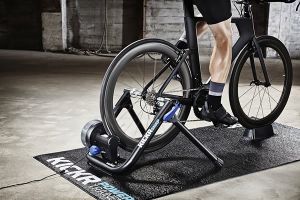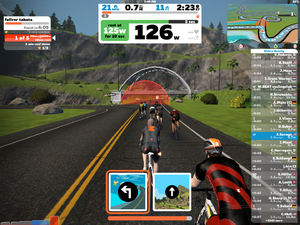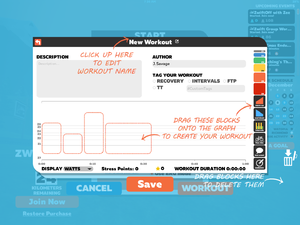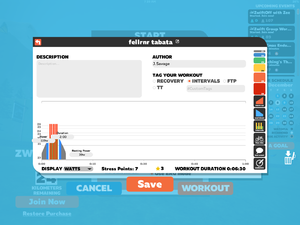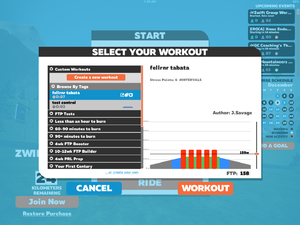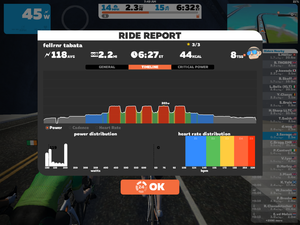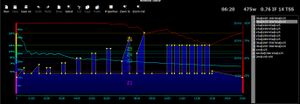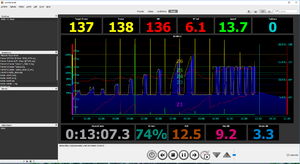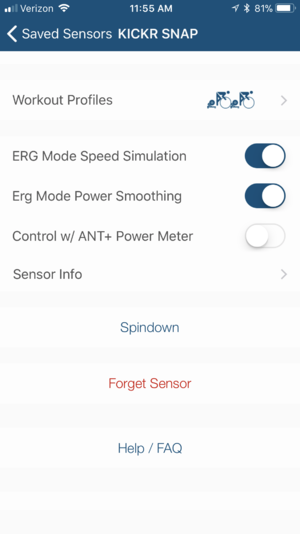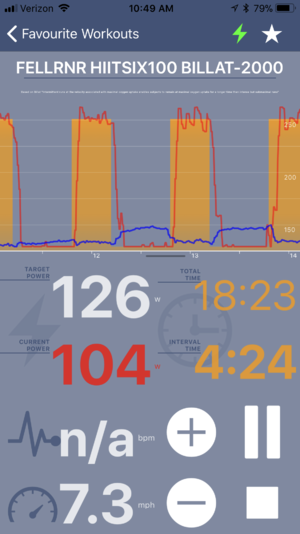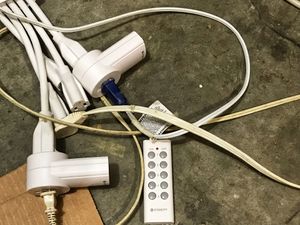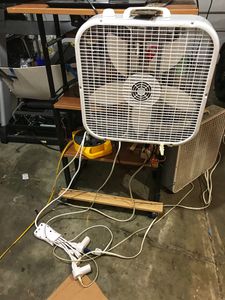Cycling HIIT For Runners
High Intensity Interval Training has been shown to be a highly effective form of exercise, but running at very high intensities is problematic. If you run much faster on level ground, your stride becomes a radically different as you are sprinting more than running, and this is elongation of your stride increases injury risk quite dramatically. It's also very hard to keep your running form under control at such high speed and high intensity. Running uphill alleviates this someone, but it's hard to find a hill long enough and steep enough, and even then, the biomechanics are different enough that you're training somewhat different muscle groups. These differences are one of the reasons for the increase in injury risk. One solution to the injury risk is to train on a stationary bike. If you're out of the saddle, your muscle recruitment is somewhat similar to running, but with much a lower injury risk. This page is a guide to performing HIIT on a stationary bike for runners. Some of this may apply to cyclists, but a cyclist will have somewhat different requirements as they will perform more than just HIIT on the stationary bike.
Contents
[hide]1 The Trainer
Unlike running, you'll need rather more equipment. I chose the Wahoo Kickr Snap, a "wheel-on smart trainer" which is cycling a talk that means you put a bike with its rear wheel in place on to the trainer. You can get the Kickr as a "direct drive", but you need a bicycle that's compatible (I didn't) and it's a lot more expensive, and as runners over frugal lot. The "smart trainer" is more than just marketing, and it means that the trainer can be controlled wirelessly. There are several wireless control modes, such as simulation where software tells the trainer to mimic going uphill. However, for HIIT the interesting one is ERG mode, where the trainer requires you to generate a certain fixed amount of power. This is a bit weird at first, as it means that the faster you pedal, the less resistance, and if the required power is too much and you start slowing up your pedaling, the resistance goes up to maintain the same power output. The Kickr can be controlled using either Bluetooth or Ant+, and transmits your power and speed over both simultaneously. You do have to calibrate the Kickr using the Wahoo app. This is called a "spin down", and as the name suggests you ride the bike until you hit the specified speed, and then stop pedaling. The app measures how long it takes for the wheel to stop spinning, and uses that time to estimate the braking forces and inertia.
2 The Bike
I used a mountain bike that's nearly 30 years old, as are things like weight don't really matter. I did put on a tire specifically designed for use on an indoor trainer, as the slightly nobly tires that were on the bike made an outrageous noise. It doesn't matter about brakes, or steering, as it's a stationary bike after all. You do want comfortable handlebars, and I much prefer the straight bars of a mountain bike to the drop handlebars of a road bike. You should be spending a lot of your time out of the saddle, so that's not as important for a runner just doing HIIT as it would be for a cyclist. You certainly don't need to spend loads of money on this gorgeous leather saddle, that's design has been unchanged for over 100 years. If you look at the saddle and feel your self drawn to its beauty, then this is the dark side of cycling pulling you in.
3 Software
To get the best use out of the trainer, you'll need some software to control it. There are lots of options, but if you don't want to pay a monthly subscription, things get a little trickier. I'm assuming that as a runner, you'll only want to use the trainer for regular, short HIIT sessions.
3.1 Ant+ or Bluetooth?
Software that runs on iOS uses Bluetooth, and of course only one device can receive data from a Bluetooth sensor. This means that if you have a Bluetooth heart rate monitor, it can only be paired with iOS or a sports watch, not both at the same time. The same is true of the Bluetooth communication from the Kickr.
3.2 Zwift
You can use Zwift for free, but you're limited to 25 km per calendar month. That's really not very much, and probably not enough to support more than 2, maybe 3 HIIT sessions per month. Zwift works out your based on your power output, so cranking out lots of watts will get you through your free kilometers even faster. The good news is that Zwift has a nice visual workout editor that allows you to put together your HIIT session fairly easily. Zwift provides a virtual riding environment that's gorgeous, and each interval transition is shown by a translucent virtual barrier, so you can see the transitions coming up. I found this was a great for preparing for an upcoming interval, or holding on for an upcoming rest period. Because of Zwift scales your speed to your power output, you get a nice sense of achievement when you're pushing hard. If you do much indoor cycling, then I think it's worth considering a subscription to Zwift. The software is available as an app for an iOS or android device, and I found it worked nicely on an iPad. There is a PC version, but I never got that to work properly (I didn't try terribly hard.)
3.3 Golden Cheetah
Golden Cheetah is free, open source software that runs on a PC, Mac, or Linux server. As you might expect from something that runs on Linux, it's not terribly user-friendly, but amazingly powerful. The user interface paradigm is different to any other software I've tried, and really takes some getting used to. Even after using it for a while, it still feels clunky and awkward. That said, the workout editor is by far my favorite, being both powerful and quick to use (once you've climbed the steep and painful learning curve.) It's always a bad sign when you need to watch a video to understand how to use software, but it's the only way. Check out Workout Editor and Workout Editor QWKCODE and Edit/Run videos. You can edit a workout visually, but you can also enter what they call "QWKCODES", which is a text based entry system. So "30s@150" is 30 seconds at 150 watts. You can specify a ramp, so "30s@150-180" will ramp up from 150 watts to 180 watts over 30 seconds. You can add recovery periods, so "30s@350r30s@125" will do 350 watts for seconds then 125 watts for 30 seconds. You can add repeats by saying "6x30s@350r30s@125" for six repeats. Times can be in minutes, so "1m" for 1 minute. There may be more, but I found no documentation.
Golden Cheetah doesn't provide any kind of simulated world, but it does provide a wealth of data that they can display in real time. You'll need an Ant+ USB adapter, but GC supports a wide variety of sensors.
Golden Cheetah stores the workouts in ERG files, which encodes the interval duration as fractional minutes to two decimal places. This means that durations of 20 seconds get converted to "0.33" which will get turned back to 19 seconds, which is rather frustrating. To avoid this, you'll need to use durations that are divisible by three seconds, so instead of 20 seconds, you'll need to set 18 or 21 seconds.
3.4 Wahoo App
I really expected the Wahoo app to provide all the basic functionality you'd need. Sadly, this is not the case. You can do some manual control of resistance, but there's no way of using it to run a predefined HIIT session. You do need to use the Wahoo app to calibrate the trainer (see above), plus there are a couple of options you can set only thought the app. You can configure the trainer to simulate a speed that is proportional to the power you're applying in ERG mode. By default, it will just report the actual speed of the wheel, and in ERG mode you can be moving very slowly with huge resistance. This setting is overridden by Zwift, which uses its own speed calculation based on power and the virtual slope you're virtually riding on.
3.5 Hurts Ergo
Hurts Ergo is a free, minimalist iOS app. You have to edit the HIIT workouts using [www.73summits.com/ergdb], which I found quite cumbersome and clunky. One problem for HIIT workouts is that you have to specified duration in minutes, so 20 seconds is 0.333… minutes, which is unintuitive at best. The app itself doesn't work terribly well, and I found that fractional minutes didn't always results in predictable interval lengths. So sometimes 0.33 minutes was 17 seconds, and sometimes 23 seconds, which is really annoying. On the other hand, it's a simple, fairly easy to use app.
4 Other Equipment
You'll need a fan. In fact, you'll probably need several really big fans. Ideally, you want some way of turning the fans on while you're riding a bike. It can be chilly when you first start, but by the time you've warmed up you'll want some air movement. In fact, overheating can be a real problem doing HIIT on a stationary bike. To prevent overheating, your subconscious will reduce muscle recruitment well ahead of serious problems arising, so you may feel weak before you feel hot. One approach to cooling that I found helpful is to put a remote-control adapter onto my box fans. This is much cheaper than buying a fan with a remote control, and also makes it easier to control up to 5 fans from one remote. I got the Etekcity Five Pack Remote Control which has 2 remote controls, and 5 power adapters. This allows me to start working out without any air movement, and gradually increase the number of fans as a warm-up.
Having some water handy is also a good idea. You're unlikely to dehydrate much during a short HIIT session, but I find the heavy breathing tends to try my throat out. Chewing on a mint can help a little by getting the saliva flowing, as saliva is far more lubricating than water.
5 What Watts?
Cyclists have been using the power meters of the years, and have a number of terms that are likely to be unfamiliar to runners.
- FTP. This is "Functional Threshold Power" and is the maximum power that can be sustained for an hour. Cyclists used this rather like a runner would use their "5K pace", though cyclists often use percentages of FTP. (FTP is a trademark of Training Peaks.)
- CP. Critical Power is the power that can be maintained 'indefinitely' or for a 'very long time without fatigue'[1], though this has been redefined so "indefinitely" is ~30-minutes[2]. CP is generally between Lactate Threshold and V̇O2max.
- Power Curve. If you measure your CP for different durations you build up a curve, which is sometimes called the power curve or power-duration curve.
- Power at V̇O2max. This is one that cyclists may not refer to commonly, but is a very common intensity for HIIT workouts used in scientific research. For instance, the well-known Tabata workout is performed at 170% of the power at V̇O2max.
- W′. Pronounced "double-u prime", can be thought of as a measure of anaerobic capacity[3]. It's the work that can be performed above CP, in Joules. W' is actually the shape of the power-duration curve. W' can be used to estimate the point of failure for anaerobic exercise, something that Golden Cheetah will visualize for you. So exercise above CP will result in a depletion of W', and when W' hits zero, you should be at failure.
6 Estimating Power At V̇O2max From Running Performance
If you're a runner, there's a good chance you'll have no idea where to start in setting up a power based workout. I did a little research on the topic, and based on nine studies I found that you can get a rough estimate of power at V̇O2max from V̇O2max which in turn you can estimate from your running performance. I refined that formula based on a study of 1,715 subjects that I found later[4].
- The first step is to estimate your V̇O2max, which you can do using my Running Calculator (or anybody else's as there are lots on the Internet.) You'll need to enter a recent race performance, though you could use a 5K time trial from training. For instance, a three-hour marathon represents a V̇O2max of 54. (Cycling V̇O2max is likely to be a little different to your running value, but it's good enough for this estimate.)
- There is a relationship between V̇O2max and power at V̇O2max which varies based on sex.
- Example, for my V̇O2max of 54, is ((54-7)/10.791), or 4.36 Watts/Kg.
- Multiplied by my weight in kilograms to get total power. Multiplying 4.36 Watts/Kg by 63 Kg gives 274 Watts.
This gives a starting point for HIIT. While it's tempting to aim for interval intensities above your power at V̇O2max, I'd strongly suggest you start somewhat lower and build up. You can build up the intensity either over several sessions, or have increasing intensity intervals during a single workout. You'll also find that as you get use to the cycling, the power you can output will increase quite a bit.
7 Estimating Power At V̇O2max From Submaximal Incremental Test
If you know your [Maximum Heart Rate]] from a running test, you can perform a submaximal incremental test on the bike to estimate your Power at V̇O2max. Knowing your maximum heart rate requires a stress test, as it cannot be calculated! But, if you do happen to know your maximum heart rate, perhaps from a running V̇O2max test, or perhaps from a finishing kick during a short race, this is another approach to consider. Simply warm up, and then perform an incremental test, recording your heart rate. Make sure you don't get hot, as this will skew the results. I use to five steps going from 150w to 350w in 50w increments. The steps need to be long enough for your heart rate to stabilize, and you take the average heart rate from the last section of each step. For instance, my results were 150w/137, 200w/144, 250w/155, 300w/166, 350/169. Plotting that in Excel gives R2 value of 0.98. This predicts my power at V̇O2max to be about 455w, which is close to the calculation above.
8 Measuring Power At V̇O2max
The best solution is obviously to perform a V̇O2max test. If you're going to go through the pain and suffering of the maximal incremental stress test, then I'd recommend doing it at a lamp where they can measure your oxygen consumption. You could do a similar test at home with a cycling trainer, but obviously you won't know your oxygen consumption unless you have the budget for lab great gear. Getting the incremental steps right seems to be a bit of a dark art. Typically the steps are 60 seconds long and aim to produce exhaustion in 3-6 minutes. The increments need to be coarse enough to produce voluntary exhaustion, while fine enough to give a reasonable precision. I've seen steps of 25w used in research papers. You'll know when you've hit V̇O2max when the power increases, but your heart rate does not. This deflection is considered the definition of V̇O2max, where work increases but oxygen consumption does not. Note that it's estimated that half of all subjects never demonstrate the heart rate/oxygen consumption deflection that's part of the definition of V̇O2max.
9 References
- Jump up ↑ DW. Hill, The critical power concept. A review., Sports Med, volume 16, issue 4, pages 237-54, Oct 1993, PMID 8248682
- Jump up ↑ David C. Poole, Mark Burnley, Anni Vanhatalo, Harry B. Rossiter, Andrew M. Jones, Critical Power, Medicine & Science in Sports & Exercise, volume 48, issue 11, 2016, pages 2320–2334, ISSN 0195-9131, doi 10.1249/MSS.0000000000000939
- Jump up ↑ Toshio Moritani, Akira Nagata, Herrfrt A. Devries, Masuo Muro, Critical power as a measure of physical work capacity and anaerobic threshold, Ergonomics, volume 24, issue 5, 2007, pages 339–350, ISSN 0014-0139, doi 10.1080/00140138108924856
- Jump up ↑ Christina G. de Souza e Silva, Claudio Gil S. Araújo, Sex-Specific Equations to Estimate Maximum Oxygen Uptake in Cycle Ergometry, Arquivos Brasileiros de Cardiologia, 2015, ISSN 0066-782X, doi 10.5935/abc.20150089
